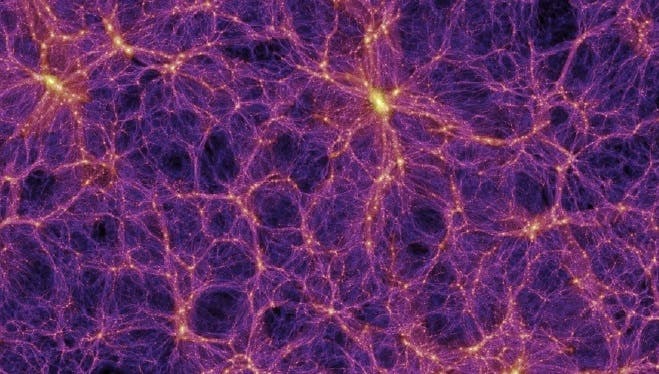Scientists have been analyzing high-energy gamma rays originating from the center of our galaxy and they’ve reported that there’s a good chance that at least some of them come from dark matter. This is the best indication of dark matter to ever be found.
What is dark matter?

Artistic representation of dark matter. There is no indication that dark matter is tangled like this.
Think about our universe for a moment – what is it made of? “Well I don’t know”, you might say, “stuff? Stars, planets, all that?”. Mmm, as it turns out, you’d be pretty off with that answer. Planets, stars, and everything that we call matter only makes up 5% of the Universe – that’s what the current understanding is. As for that 95%, dark energy is 68%, and dark matter is the rest, almost 27% – and we don’t know what those things are. We just know they’re there because we see their effects, but we don’t really know what they are. Dark energy is a hypothetical form of energy that permeates all of space and is believed to accelerate the expansion of the universe. But here, we’re more interested in dark matter.
To put it simply, dark matter is the thing which causes some gravitational effects and can’t be explained with anything else. It cannot be seen directly with telescopes; evidently it neither emits nor absorbs light or other electromagnetic radiation. Scientists can’t “see” or detect it directly in any way, but they observed some consistent gravitational effects where there shouldn’t be any gravity; the existence and properties of dark matter are inferred from its gravitational effects on visible matter, radiation, and the large-scale structure of the universe.
Detecting dark matter
Using data collected from NASA’s Fermi Gamma-ray Space Telescope, scientists from different institutions generated maps of the center of the galaxy. They found that some of the gamma-ray radiations can’t be explained through any known mechanism. It’s not just that they eliminated all the possible causes, they were still stuck with some radiation, and said “hey, look, this must be dark matter”. But then again… it’s not far off from that either.
The thing is, if dark matter particles with a particular mass are destroying each other, this would be a remarkable fit for the remaining emission. There is no real direct evidence to this, but there’s a lot of indirect indications. However, astronomers still warn that there might be other, currently unknown sources.
Elliott Bloom, a member of the Fermi collaboration, underlines that at this point, this can’t be confirmed or refuted as dark matter, but if they find a similar, stronger signal, that could confirm it.
“If we ultimately see a significant signal, it could be a very strong confirmation of the dark matter signal claimed in the galactic center.”









